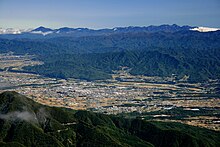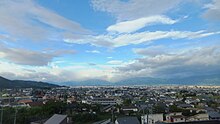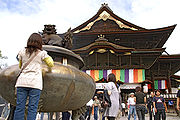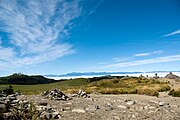Nagano Prefecture
Nagano Prefecture
長野県 | |
|---|---|
| Japanese transcription(s) | |
| • Japanese | 長野県 |
| • Rōmaji | Nagano-ken |
 | |
| Country | Japan |
| Region | Chūbu (Kōshin'etsu) |
| Island | Honshu |
| Capital | Nagano |
| Subdivisions | Districts: 14, Municipalities: 77 |
| Government | |
| • Governor | Shuichi Abe |
| Area | |
| • Total | 13,561.56 km2 (5,236.15 sq mi) |
| • Rank | 4th |
| Population (June 1, 2019) | |
| • Total | 2,052,493 |
| • Rank | 16th |
| • Density | 150/km2 (390/sq mi) |
| ISO 3166 code | JP-20 |
| Website | www |
| Symbols of Japan | |
| Bird | Rock ptarmigan (Lagopus muta) |
| Flower | Gentian (Gentiana scabra var. buergeri) |
| Tree | White birch (Betula platyphylla var. japonica) |
Nagano Prefecture (長野県, Nagano-ken) is a prefecture of Japan located in the Chūbu region of Honshū.[1] Nagano Prefecture has a population of 2,052,493 (1 June 2019) and has a geographic area of 13,561 km² (5,236 sq mi). Nagano Prefecture borders Niigata Prefecture to the north, Gunma Prefecture to the northeast, Saitama Prefecture to the east, Yamanashi Prefecture to the southeast, Shizuoka Prefecture and Aichi Prefecture to the south, and Gifu Prefecture and Toyama Prefecture to the west.
Nagano is the capital and largest city of Nagano Prefecture, with other major cities including Matsumoto, Ueda, and Iida.[2] Nagano Prefecture has impressive highland areas of the Japanese Alps, including most of the Hida Mountains, Kiso Mountains, and Akaishi Mountains which extend into the neighbouring prefectures. The abundance of mountain ranges, natural scenic beauty, and rich history has gained Nagano Prefecture international recognition as a world-class winter sports tourist destination, including hosting the 1998 Winter Olympics and a new Shinkansen line to Tokyo.
History
Geography
Nagano is an inland prefecture and it borders more prefectures than any other in Japan, bordering Gunma Prefecture, Saitama Prefecture, Yamanashi Prefecture, and Shizuoka Prefecture to the east, Niigata Prefecture to the north, Toyama Prefecture and Gifu Prefecture to the west, and Aichi Prefecture to the south. Nagano contains the point furthest from the sea in the whole of Japan—this point lies within the city of Saku. The province's mountains have made it relatively isolated, and many visitors come to Nagano for its mountain resorts and hot springs. Nine of the twelve highest mountains in Japan can be found in Nagano and one of its lakes, Lake Kizaki, is a beach resort popular for its water attractions and games.
As of 1 April 2014, 21% of the total land area of the prefecture was designated as Natural Parks; namely the Chichibu Tama Kai, Chūbu-Sangaku, Jōshin'etsu Kōgen, and Minami Alps National Parks; Myōgi-Arafune-Saku Kōgen, Tenryū-Okumikawa, and Yatsugatake-Chūshin Kōgen Quasi-National Parks; and Chūō Alps, Enrei Ōjō, Hijiriyama Kōgen, Mibugawa Suikei, Ontake, and Tenryū Koshibu Suikei Prefectural Natural Parks.[3]
Cities


City Town Village







Nineteen cities are located in Nagano Prefecture:
Towns and villages
These are the towns and villages in each district:
Mergers
Demographics
| Year | Pop. | ±% p.a. |
|---|---|---|
| 1880 | 1,000,414 | — |
| 1890 | 1,146,071 | +1.37% |
| 1903 | 1,348,556 | +1.26% |
| 1913 | 1,484,205 | +0.96% |
| 1920 | 1,562,722 | +0.74% |
| 1925 | 1,629,217 | +0.84% |
| 1930 | 1,717,118 | +1.06% |
| 1935 | 1,714,000 | −0.04% |
| 1940 | 1,710,729 | −0.04% |
| 1945 | 2,121,050 | +4.39% |
| 1950 | 2,060,831 | −0.57% |
| 1955 | 2,021,292 | −0.39% |
| 1960 | 1,981,433 | −0.40% |
| 1965 | 1,958,007 | −0.24% |
| 1970 | 1,956,917 | −0.01% |
| 1975 | 2,017,564 | +0.61% |
| 1980 | 2,083,934 | +0.65% |
| 1985 | 2,136,927 | +0.50% |
| 1990 | 2,156,627 | +0.18% |
| 1995 | 2,193,984 | +0.34% |
| 2000 | 2,215,168 | +0.19% |
| 2005 | 2,196,114 | −0.17% |
| 2010 | 2,152,449 | −0.40% |
| 2015 | 2,099,759 | −0.49% |
| 2020 | 2,052,493 | −0.45% |
| source:[4] | ||
The life expectancy in Nagano prefecture is the longest nationwide with the average life expectancy of 87.18 years for women and 80.88 years for men.[5]
Transportation
Railway
- East Japan Railway Company
- Hokuriku Shinkansen
- Shin'etsu Main Line
- Chūō Main Line (east line)
- Shinonoi Line
- Ōito Line (from Matsumoto to Minami-Otari)
- Koumi Line
- Central Japan Railway Company
- Chūō Main Line (west line)
- Iida Line
- West Japan Railway Company
- Ōito Line (from Minami-Otari to Itoigawa)
- Shinano Railway
- Nagano Electric Railway
- Nagano Line
- Matsumoto Electric Railway
- Ueda Dentetsu
Road
Expressways
- Chuo Expressway
- Nagano Expressway
- Joshinetsu Expressway
- Sanen-nanshin Expressway
- Chubu-jukan Expressway
- Chubu-odan Expressway
National highways
- Route 18
- Route 19 (Nagano-Matsumoto-Shioriri-Nagiso-Nakatsugawa-Tajimi-Nagoya)
- Route 20 (Matsumoto-Suwa-Kofu-Otsuki-Hachioji-Nihonbashi of Tokyo)
- Route 117
- Route 141
- Route 142
- Route 143 (Matsumoto-Azumino-Ueda)
- Route 144
- Route 147 (Matsumoto-Omachi)
- Route 148 (Omachi-Itoigawa)
- Route 151 (Iida-Shinshiro-Toyohashi)
- Route 152
- Route 153 (Nagoya-Toyota-Iida-Shioriri)
- Route 158 (Fukui-Gujo-Takayama-Matsumoto)
- Route 254
- Route 256 (Gifu-Gujo-Gero-Nakatsugawa-Nagiso-Iida)
- Route 403
- Route 406 (Omachi-Hakuba-Nagano-Susaka-Tsumagoi-Takasaki)
- Route 418 (Ono-Seki-Ena-Iida)
Airports
Education
Universities
Public
- Shinshu University (National)
- Nagano College of Nursing (Prefectural)
- The University of Nagano (Prefectural)
- Nagano University [Municipal (Ueda City)]
- Suwa Tokyo University of Science [Municipal (Chino City)]
Private
- Matsumoto University (Private)
- Matsumoto Dental University (Private)
- Saku University (Private)
- Seisen Jogakuin College (Private)
Economy
Nagano Prefecture has a large and diversified economy, with a strong focus on electronics, information technology, precision machinery, agriculture and food products, and tourism, with a total GDP of about 8.5 Trillion Yen (2014).[6]
Several large Japanese groups have production facilities in Nagano Prefecture, such as Citizen Watch (Citizen Group), MinebeaMitsumi, Seiko Epson or Vaio.
Tourism
- Lake Kizaki
- Lake Suwa
- Mount Kirigamine
- Suwa Taisha, one of the oldest shrines in Japan
- Matsumoto Castle, one of Japan's national treasures
- One of the world's highest geysers (about 40 to 50 meters) in Suwa
- Zenkō-ji temple in Nagano city
Sports

There are two local J.League clubs: AC Nagano Parceiro and Matsumoto Yamaga FC.
Prefectural symbols
- Siberian Silver Birch
- Gentian
- Ptarmigan
- Japanese Serow
- Shinano no Kuni (prefecture song)
Sister Regions
 Changhua County, Taiwan (2008)
Changhua County, Taiwan (2008) Hebei, China
Hebei, China Missouri, USA
Missouri, USA
Personalities
- Nagano's former governor, Yasuo Tanaka, is an independent who has made a reputation internationally for attacking Japan's status quo. Among other issues, he has refused national government money for construction projects that he deems unnecessary, such as dams, and has overhauled (locally) the press club system that is blamed for limiting government access to journalists who give favorable coverage. Tanaka was voted out from office on August 6, 2006 and was replaced by Jin Murai.
- Tatsumi Yoda (aka Tom Yoda), former chairman of Avex, is from Chikuma-shi.
- Glim Spanky, the members of the rock band are from Nagano Prefecture
- Yuto Adachi, of Korean boy group Pentagon is from Nagano Prefecture
- Yasuyuki Kazama, a professional drift driver, is from Shimosuwa in Nagano Prefecture.
- Keiichi Tsuchiya, a professional racing driver, is from Tōmi in Nagano Prefecture.
See also
Notes
- ^ Nussbaum, Louis-Frédéric. (2005). "Nagano prefecture" in Japan Encyclopedia, p. 682, p. 682, at Google Books; "Chūbu" at p. 126, p. 126, at Google Books
- ^ Nussbaum, "Nagano" at p. 682, p. 682, at Google Books
- ^ "General overview of area figures for Natural Parks by prefecture" (PDF). Ministry of the Environment. 1 April 2014. Retrieved 28 September 2017.
- ^ Statistics Bureau of Japan
- ^ Nagano Prefecture has achieved the highest life expectancy in Japan, after long efforts of improving each one’s lifestyle (December 9, 2013). Foreign Press Center/Japan
- ^ https://www.jetro.go.jp/en/invest/region/nagano/
References
- Nussbaum, Louis-Frédéric and Käthe Roth. (2005). Japan encyclopedia. Cambridge: Harvard University Press. ISBN 978-0-674-01753-5; OCLC 58053128
External links
 Media related to Nagano Prefecture at Wikimedia Commons
Media related to Nagano Prefecture at Wikimedia Commons- Nagano Prefecture Official Website (in Japanese)
- Nagano Prefecture Official Website (in English)
- Nagano Prefecture Tourism Website (in English)









